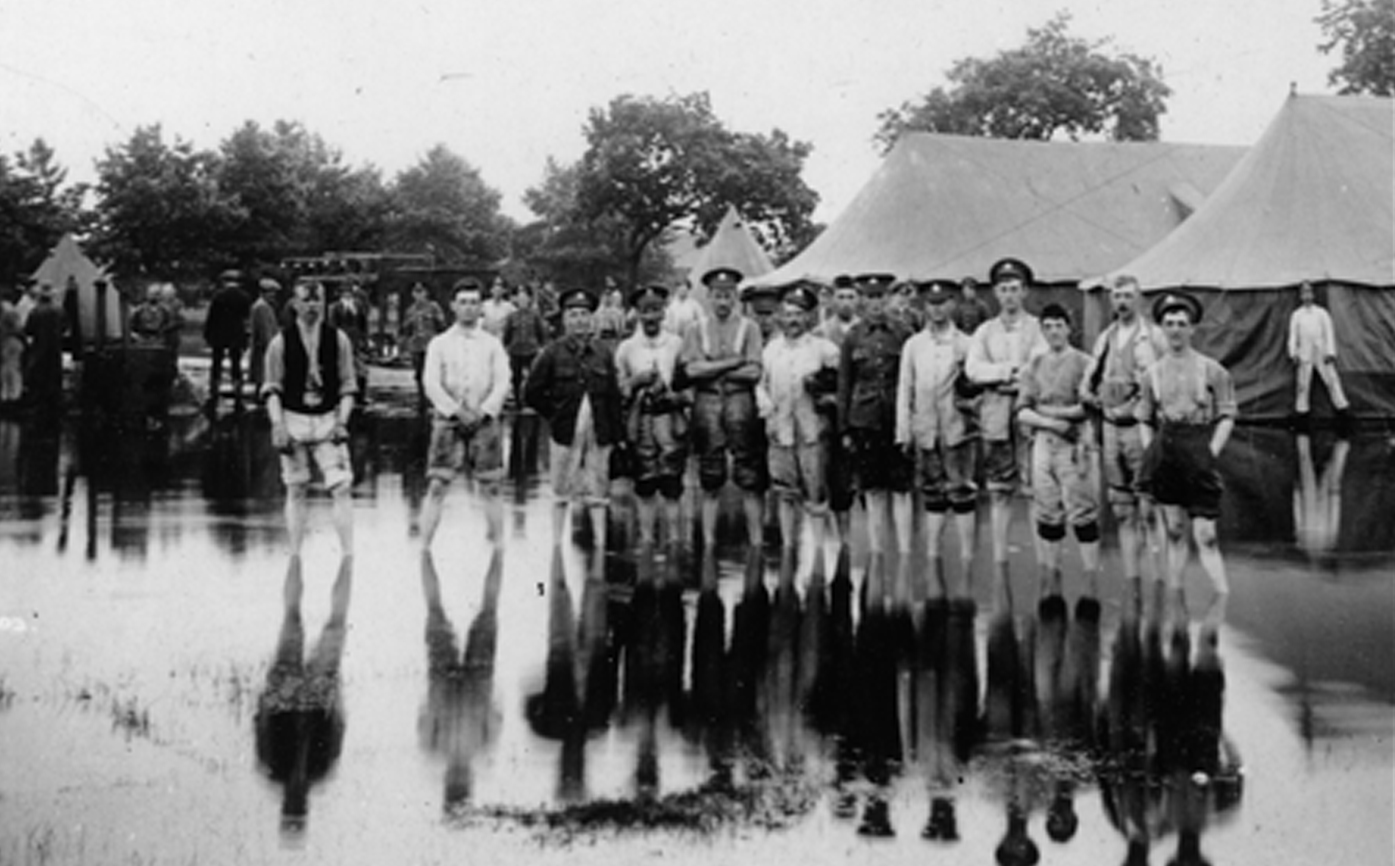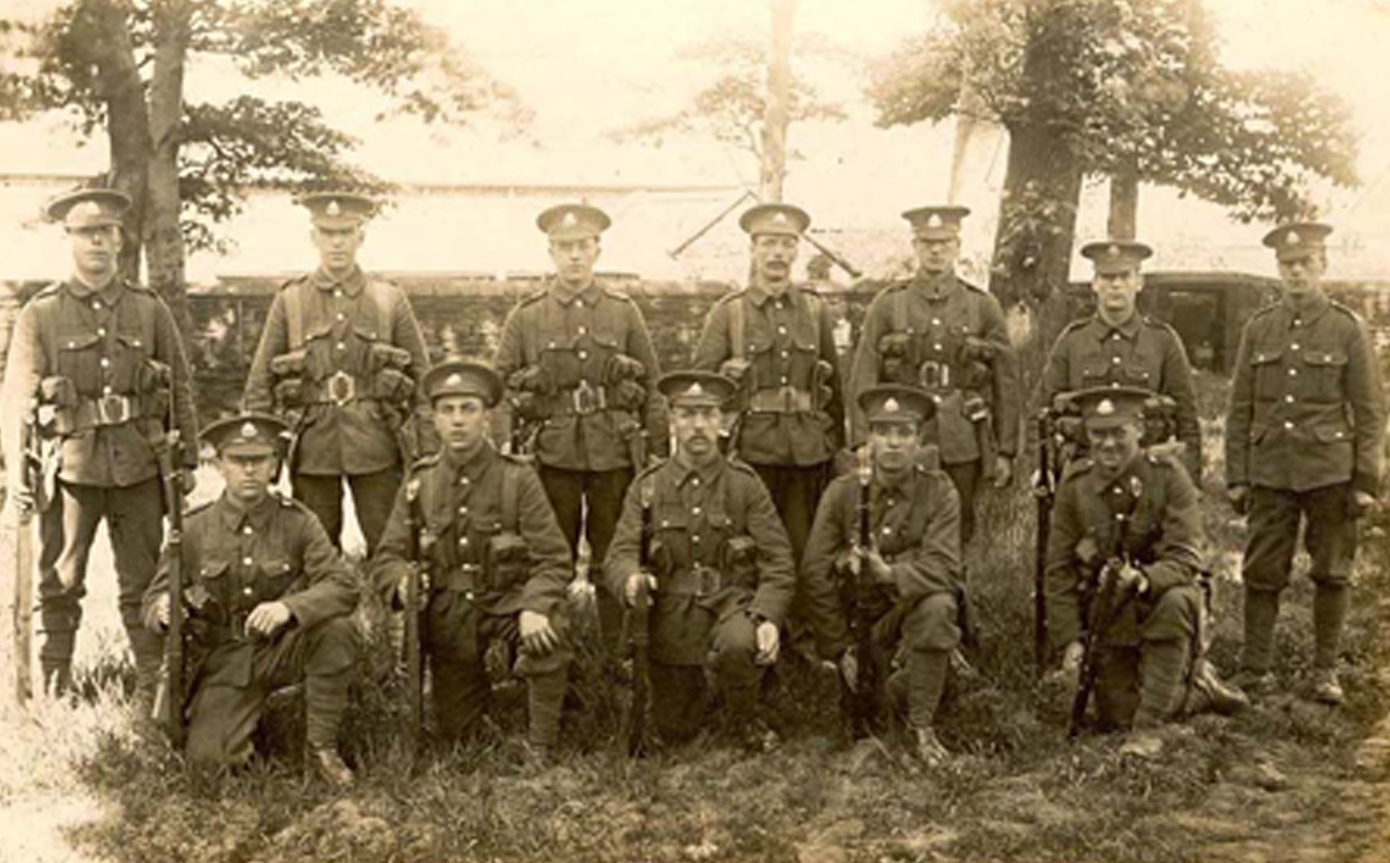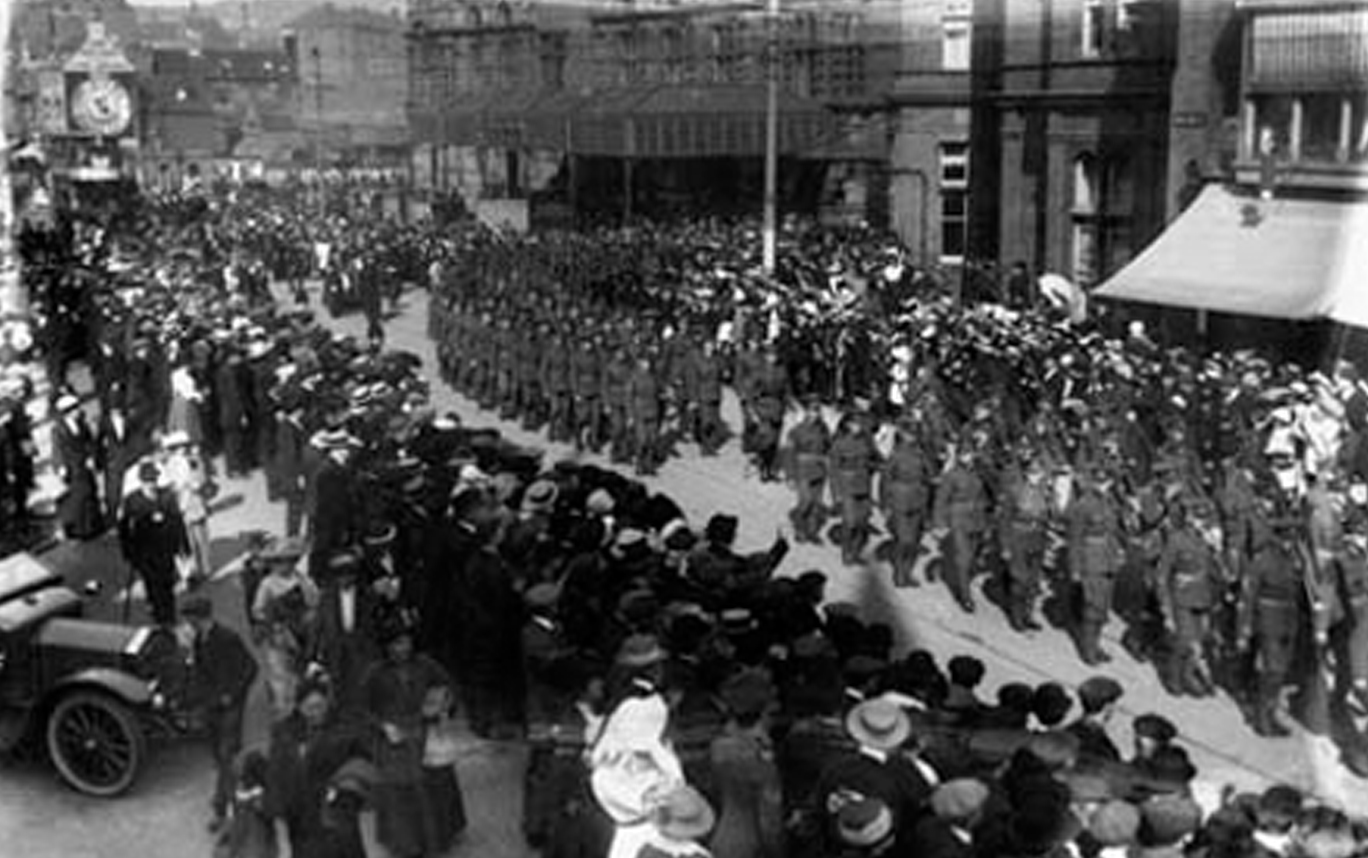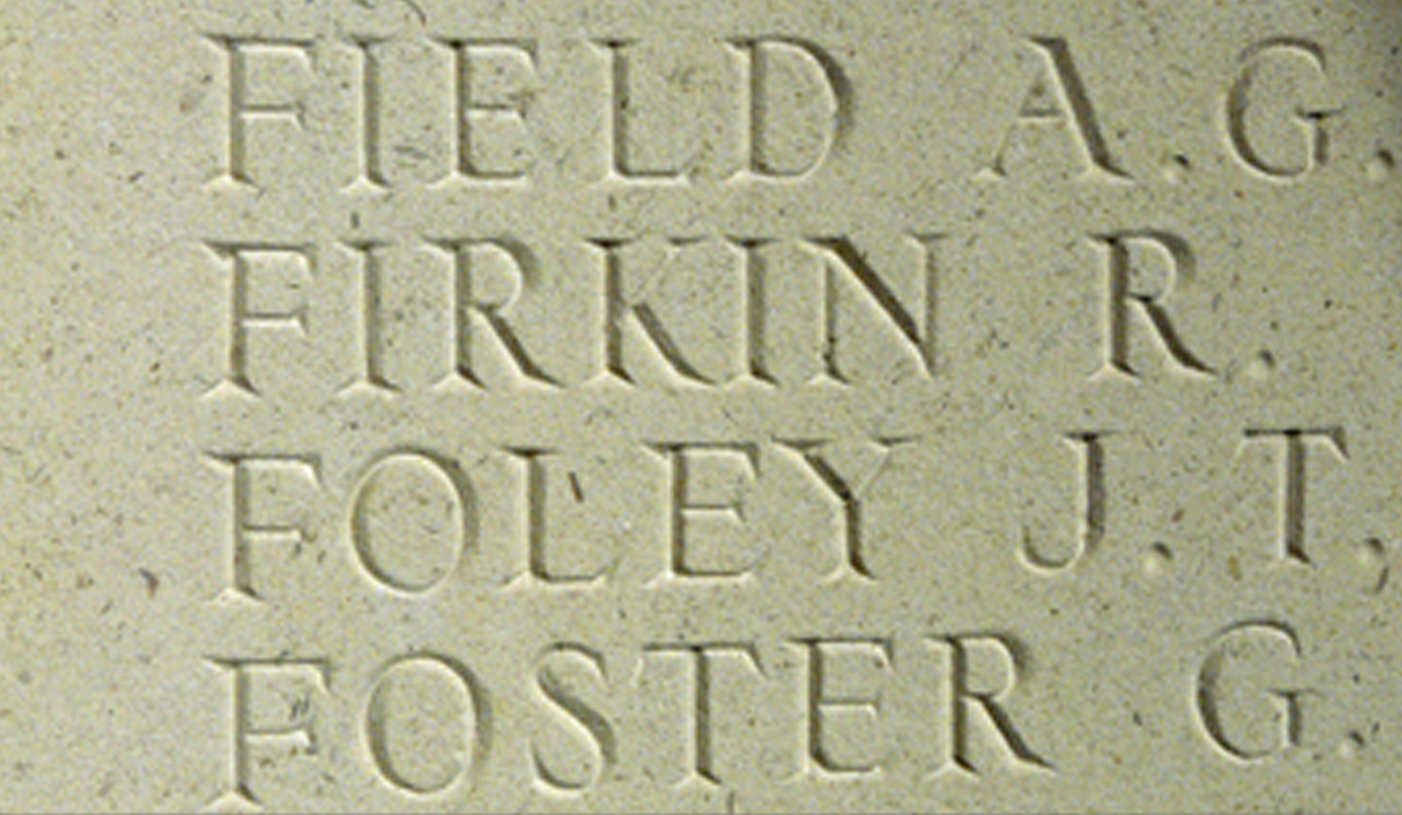Born and Bred
A Yorkshire Family
Richard Firkin
My Great-Grandfather
Richard's Story
Richard Firkin was born on the 15th of July 1891 in Nottingham, the eldest son of Richard Firkin and Elizabeth Scott. In 1909, he was working as a general labourer and possibly to earn a little extra, or for the excitement of it, he decided to join the 4th Battalion (Special Reserve) of the Sherwood Foresters. He enlisted on the 23rd of September for a period of six years as Private 4059 Richard Firkin.
Recruits of the Special Reserve were required to undergo six months training to start with. During that period they received pay varying from 7s to 10s a week in addition to food and quarters. The period of enlistment was for six years. After the first six months drill the only obligation incurred was to attend a fortnight or three weeks training each year. The annual training dates were to be arranged to meet local conditions i.e. "when was best for men and masters". Richard would have received some basic training when he joined and then once a year until war broke out.

Unfortunately, there are no verified photos of him, however, there is a photograph of the 4th Battalion in a flooded area of their training camp at Strensall, North Yorkshire in 1912. Maybe, one of those young men staring out of the picture is Richard, we shall never know.
On the 28th of June 1914, Archduke Ferdinand of Austria was assassinated and the nations of Europe and subsequently most of the world were set upon the path to what would become known as "The Great War". When Germany instigated the Schlieffen Plan and invaded neutral Belgium on the 4th of August 1914, Britain was forced to declare war on Germany, in support of her allies Russia and France and three days later Lord Kitchener called for 100,000 men to join the British Army.

The Special Reserve, which Richard had joined back in 1909, was a Reserve Battalion, that was liable for service overseas. If needed, it could be called up at any moment and hence was why the Battalion was mobilised on the 6th of August 1914 for further training. On the 25th of September members of the Special Reserve were automatically transferred to the 1st Battalion, which was currently suffering heavy casualties fighting in France.
On the 26th of December 1914, Richard embarked on a troopship leaving Plymouth. He arrived in France at Le Havre the following day. After at short stay, possibly at No. 6 Camp, North East of Le Havre, he boarded a train at the Gare des Marchandises to Merville, some 27 miles west of Lille. He then began marching to join the rest of the 1st Battalion who had just rotated out of the front lines and were now in billets as part of the Brigade Reserve at a place known as the "Red Barn" near Richebourg, arriving there on the 3rd of January 1915.

On the 24th of January 1915, the Battalion once again moved into the front lines, completing this by 1:15am on the 25th. Later on that morning the Germans "started bombing, shelling & heavy fire", this continued for about 2 hours and then died down. During the day the Battalion suffered 5 killed and 39 wounded, one of the wounded was Richard Firkin.
After receiving preliminary medical attention at an aid post close to the front line, Richard was transferred to the 25th Field Ambulance "25 FA". The Field Ambulance was a mobile medical unit, not a vehicle. Each British division had three such units. The Field Ambulances provided the bearer posts but also established Main and Advanced (that is, forward) Dressing Stations where a casualty could receive further treatment and be got into a condition where he could be evacuated to a Casualty Clearing Station.
Richard had suffered an "Abrasion" to the head, later re-classified as a "GSW Head Severe". GSW is an abbreviation for "Gun Shot Wound" but this does not necessarily mean Richard suffered a bullet wound as the phrase covers a range of wounds, such as shrapnel from an exploding shell, much more likely considering the action that resulted in him being wounded. He was transferred to No. 6 Casualty Hospital in Rouen.
Casualty Clearing Stations, also known as Clearing Hospitals until early 1915. The CCS was the first large, well-equipped and static medical facility that the wounded man would visit. Its role was to retain all serious cases that were unfit for further travel; to treat and return slight cases to their unit; and evacuate all others to Base Hospitals. It was often a tented camp, although when possible the accommodation would be in huts. Casualty Clearing Stations were often grouped into clusters of two or three in a small area, usually a few miles behind the lines and on a railway line. A typical CCS could hold 1,000 casualties at any time, and each would admit 15 to 300 cases, in rotation.
He stayed there for 13 days before being discharged and transferred back to his unit on the 9th of February, fit for duty. He then rejoined his Battalion who were now once again in their billets at "Red Barn". Two days later they were back in the front lines.
The Battle of Neuve Chapelle was the first large scale organised attack undertaken by the British Army during the war. It followed the miserable winter operations of 1914-15. More Divisions had now arrived in France and the British Expeditionary Force was now split into two Armies. Neuve Chapelle was undertaken by Sir Douglas Haig's First Army
At 12:19pm on the 11th of March, uncompromising orders came down to the Battalion:
"It is most important that the buildings at the Moulin du Pietre and at the Mauquissart - Pietre cross roads should be captured without further delay".
Attempts by the Northants, Sherwood Foresters and two companies of Worcesters met with costly failure. They were being shot down like targets at a fairground. The only progress, if it can be called that, was the occupation, at great loss of life, by the Sherwood Foresters of two isolated and damaged buildings by the Mauquissart Road. This position, which was later to achieve notoriety, was subsequently renamed "The Duck's Bill".
Officially the Battle of Neuve Chapelle ended during the night on the 12th of March 1915. The British and Indian casualty figures sustained during the three day offensive were high. Haig's First Army lost 544 officers and 11,108 men, casualties totalling 11,652. Richard Firkin was just one of these. He fell sometime on the 12th of March in the fierce fighting around the Duck's Bill. Initially he was listed as "missing", this was later changed to "Killed in Action". His body was never recovered.
Over the course of the three day battle, the Sherwood Foresters lost:
Officers ... Killed 6, Wounded 10
Other ranks ... Killed 90, Wounded 265, Missing 87
This amounts to almost half of their notional full strength ... (30 officers and 977 other ranks), which they wouldn't have had due to casualties suffered prior to the battle.
Exactly 100 years later, my father and I would walk and explore the battlefield where he fought and died. We also made a special visit the the "Le Touret Memorial to the Missing" in the Pas de Calais, where Richard Firkin's name is recorded on panels 26 and 27.


